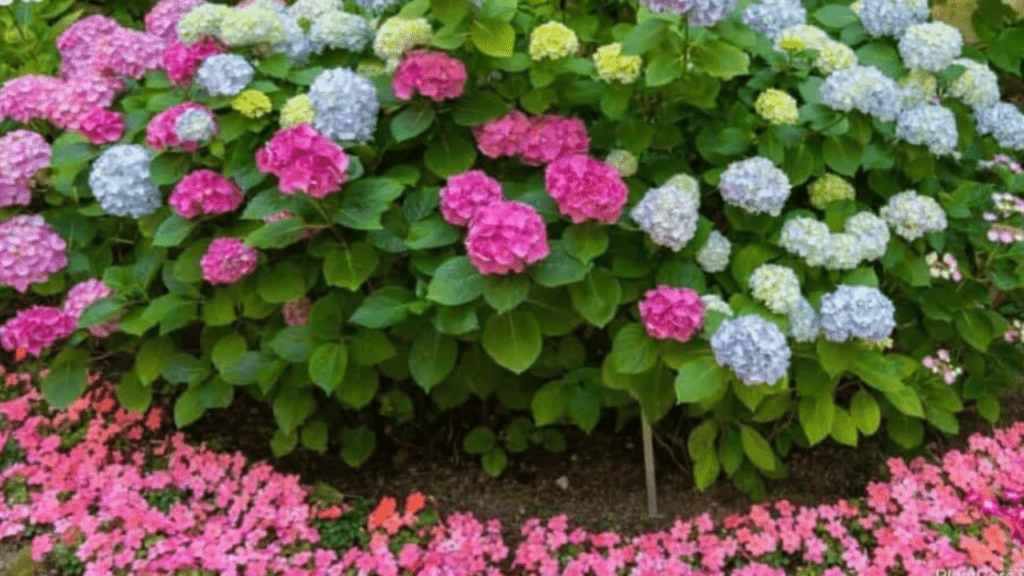
The Ultimate Guide to Hydrangea Companion Plants
Hydrangeas are beloved for their large, colorful blooms and ability to thrive in various garden settings. To enhance their beauty and ensure a healthy garden ecosystem, choosing the right hydrangea companion plants is crucial. Companion planting not only boosts the aesthetic appeal of your garden but also promotes biodiversity and helps manage pests naturally.
When it comes to choosing the perfect hydrangea companion plants, there are a few things to consider. First and foremost, you’ll want to select plants that thrive in similar growing conditions. Hydrangeas prefer moist, well-drained soil and partial shade, so look for companion plants that have similar preferences. Some great options include ferns, hostas, and astilbe, which all thrive in shady, moist environments.
In addition to matching growing conditions, consider the bloom time and color of potential companion plants. For example, pairing hydrangeas with early-blooming bulbs like daffodils or tulips can provide a stunning display of color in the spring. You can also choose plants with foliage that complements the hydrangea blooms, such as ornamental grasses or heuchera.
Beyond aesthetics, selecting the right companion plants can also benefit the overall health of your garden. For example, planting aromatic herbs like lavender or sage near your hydrangeas can help repel pests and attract pollinators, creating a more balanced and resilient ecosystem.
Table of Contents
ToggleBenefits of Companion Planting with Hydrangeas
Enhanced garden aesthetics.
Companion planting with hydrangeas can enhance the aesthetics of your garden by creating a visually appealing and harmonious environment. When choosing companion plants for hydrangeas, it’s important to consider factors such as soil conditions, sunlight preferences, bloom time, and color. Plants that thrive in similar growing conditions, such as ferns, hostas, and astilbe, make excellent companions for hydrangeas. Additionally, selecting plants with complementary foliage and bloom colors can create a stunning display throughout the growing season. Beyond aesthetics, companion planting can also benefit the overall health of your garden. For example, planting aromatic herbs near your hydrangeas can help repel pests and attract beneficial pollinators, creating a more balanced and resilient ecosystem. By carefully selecting and pairing companion plants with your hydrangeas, you can enhance the beauty and health of your garden.
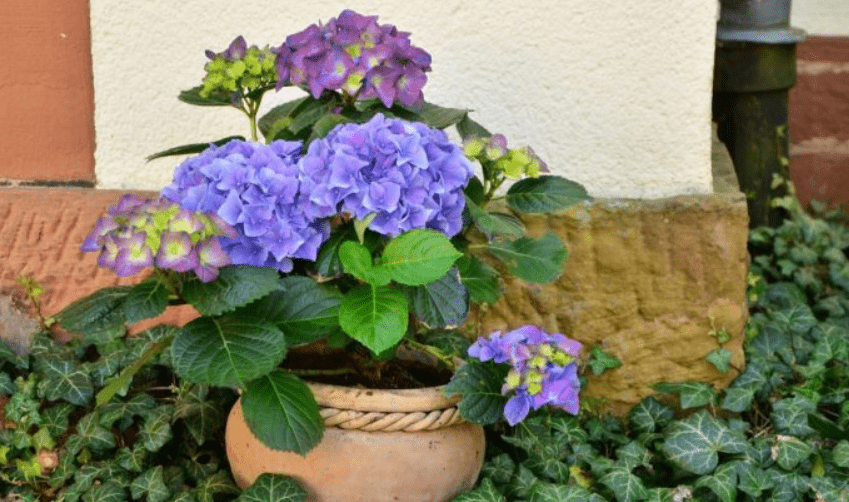
Improved soil health and structure.
Companion planting with hydrangeas is a great way to enhance the aesthetics of your garden while also improving soil health and structure. When choosing companion plants for your hydrangeas, it’s important to consider factors such as soil conditions, sunlight preferences, bloom time, and color. Plants that thrive in similar growing conditions, such as ferns, hostas, and astilbe, make excellent companions for hydrangeas. These plants not only add visual appeal but also contribute to improved soil health by providing a diverse root structure and organic matter. Additionally, selecting plants with complementary foliage and bloom colors can create a stunning display throughout the growing season. Beyond aesthetics, companion planting can also benefit the overall health of your garden. For example, planting aromatic herbs near your hydrangeas can help repel pests and attract beneficial pollinators, creating a more balanced and resilient ecosystem. By carefully selecting and pairing companion plants with your hydrangeas, you can create a visually appealing and healthy garden.
Natural pest control and attracting beneficial insects.
When it comes to natural pest control and attracting beneficial insects, companion planting is a great strategy to consider. By choosing plants that complement and support each other, you can create a more balanced and resilient ecosystem in your garden. For example, planting aromatic herbs such as lavender, mint, or rosemary near your hydrangeas can help repel pests and attract beneficial pollinators. This not only helps to keep harmful pests at bay but also contributes to the overall health of your garden. Additionally, selecting plants with similar growing conditions, such as ferns, hostas, and astilbe, can provide a diverse root structure and organic matter, improving soil health. When you carefully pair companion plants with your hydrangeas, you can create a visually appealing and healthy garden that supports natural pest control and beneficial insects.
Criteria for Choosing Hydrangea Companion Plants
When it comes to choosing companion hydrangea plants for your hydrangeas, there are a few key criteria to keep in mind. First, consider the growing conditions of your garden, including sunlight, soil type, and moisture levels. Select companion plants that thrive in similar conditions to ensure they will complement each other well. Additionally, think about the visual appeal and aesthetic you want to achieve in your garden. Choose plants with complementary colors, textures, and heights to create a balanced and cohesive look. Another important factor to consider is the seasonality of the plants. Select companion plants that bloom at different times throughout the year to ensure that your garden has continuous visual interest and supports pollinators throughout the seasons. By carefully considering these criteria, you can choose the perfect companion plants to enhance the beauty and health of your hydrangea garden.
Top Hydrangea Companion Plants
Hostas:
Description and benefits.
Hostas are an excellent companion plant for hydrangeas. They thrive in similar conditions, preferring partial shade and moist, well-drained soil. Hostas also provide a beautiful contrast in texture and shape with their large, bold leaves, which complement the delicate blooms of hydrangeas. Additionally, hostas are known for their low maintenance and ability to suppress weeds, making them a practical and aesthetically pleasing addition to your garden. Their foliage also remains attractive throughout the season, even after the hydrangea blooms have faded, ensuring continuous visual interest. Overall, hostas are a great choice for enhancing the beauty and health of your hydrangea garden.
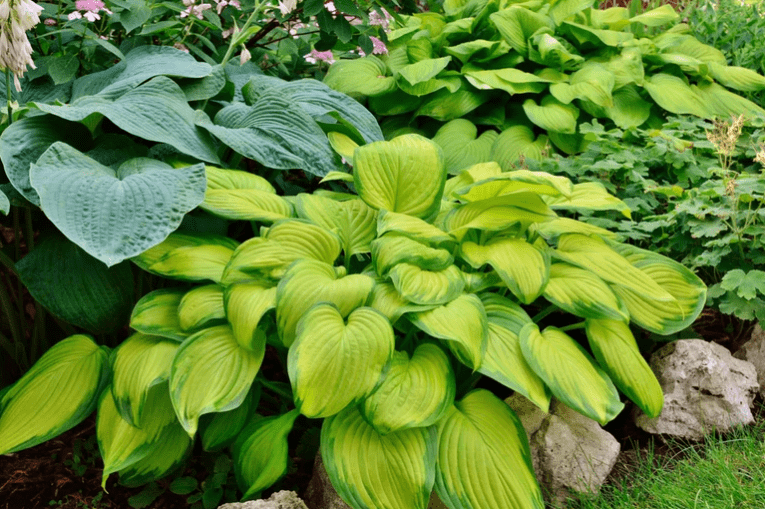
Planting tips and care.
When planting hostas as companion plants for your hydrangeas, it’s important to choose a spot that receives partial shade and has well-drained soil. Make sure to space them out appropriately to allow for air circulation and to prevent overcrowding. Water them regularly, especially during dry periods, and mulch around the base of the plants to help retain moisture and suppress weeds. Hostas are generally low-maintenance, but it’s a good idea to keep an eye out for pests or diseases and address any issues promptly. Pruning may also be necessary to keep the plants looking their best. With proper care and attention, hostas can thrive alongside your hydrangeas and enhance the overall beauty of your garden.
Ferns:
Description and benefits.
Hostas are a popular choice for adding beauty and depth to your garden. They are known for their lush, green foliage and can be used to add texture and contrast to your hydrangea garden. They also help to fill in empty spaces and create a more lush and full look. In addition to their aesthetic benefits, hostas are also great for improving the health of your garden. They can help to retain moisture in the soil and provide a natural ground cover that suppresses weeds. Plus, they attract beneficial insects and pollinators, which can help to create a more balanced and healthy ecosystem in your garden. When planting hostas, it’s important to choose a spot with partial shade and well-drained soil. Proper spacing, regular watering, and mulching are key to maintaining healthy hostas. With the right care, hostas can thrive alongside your hydrangeas and enhance the overall beauty of your garden.
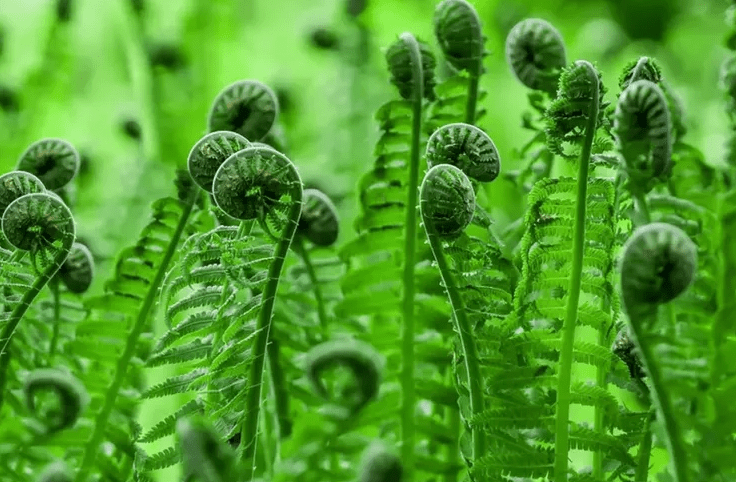
Planting tips and care.
When it comes to planting hostas, there are a few important tips to keep in mind. Hostas thrive in partial shade, so it’s important to choose a spot in your garden that receives some sunlight but is not in direct, harsh sunlight all day. Additionally, hostas prefer well-drained soil, so be sure to amend the soil with organic matter if needed to improve drainage.
When planting hostas, be sure to space them out properly to allow for adequate airflow and growth. Regular watering is key to keeping hostas healthy and vibrant, as they prefer consistently moist soil. Adding a layer of mulch around the base of the plants can help retain moisture and suppress weeds.
Hostas also benefit from occasional division, as this can help rejuvenate older plants and create more hostas for your garden. When dividing hostas, be sure to do so in the early spring before new growth appears.
Astilbes:
Description and benefits.
Astilbes, also known as false spirea, are a beautiful and versatile perennial plant that can add a pop of color to your garden. They have feathery plumes of flowers in shades of pink, red, white, and lavender, and their fern-like foliage provides a soft, elegant look. Astilbes thrive in partial shade and moist, well-drained soil, making them a great addition to a woodland garden or a shady spot in your yard. They are also deer and rabbit resistant, making them a low-maintenance option for gardeners. Astilbes are also great for attracting pollinators like bees and butterflies to your garden. They are relatively low maintenance and can be divided every few years to help them stay healthy and vigorous. With their beautiful flowers and easy care, astilbes are a great addition to any garden.
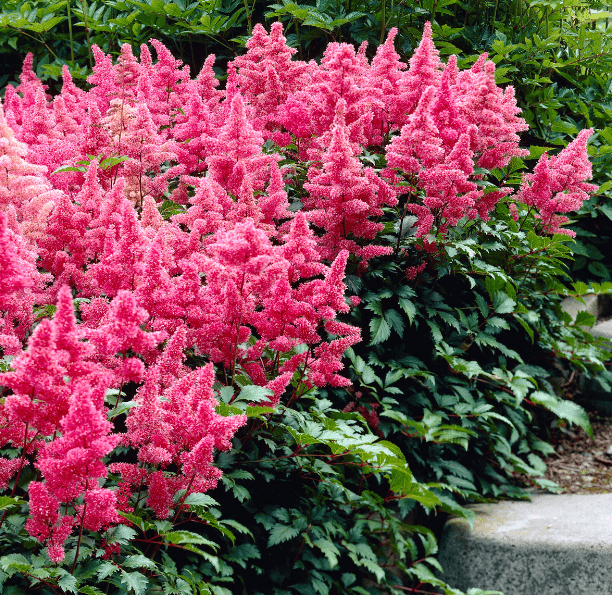
Planting tips and care.
Astilbes, also known as false spirea, are a beautiful and versatile perennial plant that can add a pop of color to your garden. To properly plant and care for astilbes, it’s important to choose a location with partial shade and moist, well-drained soil. This makes them a great addition to a woodland garden or a shady spot in your yard. When planting, make sure to space them about 18-24 inches apart to allow for proper growth and airflow. It’s also important to water them regularly, especially during dry spells, to keep the soil consistently moist. In terms of care, astilbes are relatively low maintenance and can be divided every few years to help them stay healthy and vigorous. Additionally, they are deer and rabbit resistant, making them a great option for gardeners looking for low-maintenance plants. With their feathery plumes of flowers in shades of pink, red, white, and lavender, as well as their fern-like foliage, astilbes are a beautiful addition to any garden and are great for attracting pollinators like bees and butterflies.
Japanese Maple:
Description and benefits.
Japanese maples are stunning trees that are known for their vibrant colors and unique leaf shapes. They come in a variety of sizes and can be used as a focal point in a garden or as a beautiful addition to a landscape. These trees are also low maintenance and can thrive in both full sun and partial shade, making them versatile for different garden settings. Japanese maples are also known for their adaptability to different soil types and can tolerate acidic to neutral soil. They are also relatively resistant to pests and diseases, making them a great choice for gardeners looking for a hassle-free tree to add to their landscape. Additionally, Japanese maples have a slow growth rate, making them a great option for small gardens or for those looking for a tree that won’t require constant pruning or maintenance. With their stunning fall foliage and year-round visual interest, Japanese maples are a beautiful and valuable addition to any garden.
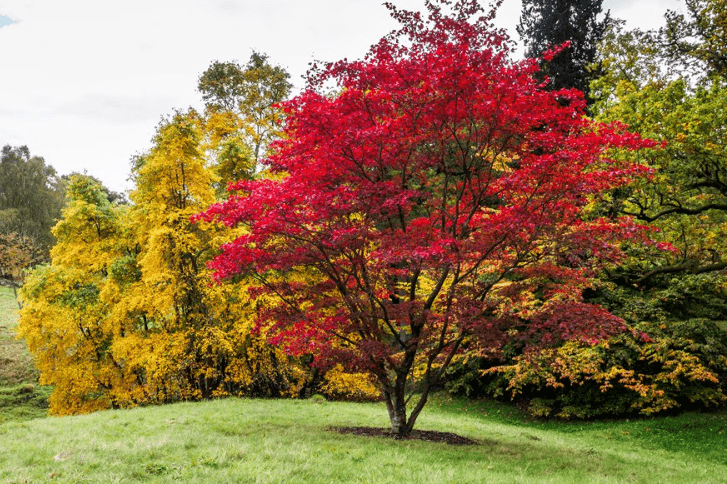
Planting tips and care.
When planting Japanese maples, it’s important to choose a location with well-drained soil and partial shade, especially in hotter climates. Make sure to dig a hole that is twice as wide and just as deep as the root ball. Gently loosen the roots and place the tree in the hole, making sure it’s level with the ground. Backfill the hole with soil and water thoroughly. Japanese maples benefit from a layer of mulch to retain moisture and regulate soil temperature. Water the tree regularly, especially during dry periods, and fertilize in the spring with a balanced fertilizer. Pruning is not necessary for the health of the tree, but can be done to maintain a desired shape or size. With proper care and attention, Japanese maples can thrive and bring beauty to any garden.
Coral Bells (Heuchera):
Description and benefits.
Coral Bells, also known as Heuchera, are a popular perennial plant known for their attractive foliage and delicate flowers. They come in a variety of colors, including shades of green, purple, and silver. Coral Bells are a great addition to any garden, as they can add texture and color to your landscape. These plants are also low-maintenance and drought-tolerant, making them perfect for busy gardeners. They can thrive in both sun and shade, making them versatile and adaptable to different gardening conditions. Additionally, Coral Bells attract pollinators such as hummingbirds and butterflies, making them a great choice for wildlife-friendly gardens. With proper care, these plants can beautify your garden for many years to come.
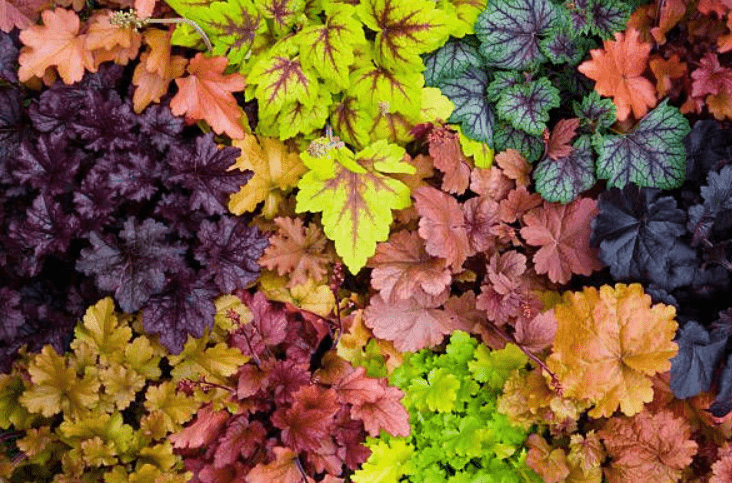
Planting tips and care.
When planting Coral Bells, it’s important to choose a location with well-drained soil and to avoid areas with standing water. Plant them at the same level they were growing in their nursery pot, and water them thoroughly after planting. It’s best to plant them in the spring or fall, when the weather is cooler and the plants can establish themselves more easily.
To care for Coral Bells, it’s important to water them regularly, especially during dry periods. Mulching around the plants can help to retain moisture in the soil. Additionally, it’s a good idea to fertilize them in the spring with a slow-release fertilizer to promote healthy growth and flowering.
As far as maintenance goes, it’s important to remove any dead or damaged leaves to keep the plant looking its best. It’s also a good idea to divide the plants every 3-4 years to prevent overcrowding and to rejuvenate them.
Overall, Coral Bells are a beautiful and low-maintenance plant that can add a pop of color to any garden. With the right care and attention, they can thrive and bring joy to your garden for years to come.
Other Notable Companions:
Example plants and their benefits.
Coral Bells are a popular plant known for their vibrant foliage and delicate, bell-shaped flowers. They are great for attracting hummingbirds and butterflies to your garden. In addition to their visual appeal, Coral Bells also have some practical benefits. They are deer resistant, making them a great option for gardens in areas with a large deer population. They are also relatively low-maintenance and can thrive in a variety of soil conditions. Another great plant to consider is Lavender. Lavender is well-known for its calming and soothing aroma, making it a popular choice for aromatherapy and relaxation. It is also a natural insect repellent, making it a great addition to a garden to help keep pesky bugs at bay. Lavender is also drought-tolerant and can thrive in dry, arid conditions, making it a great choice for water-wise gardening. Finally, Rosemary is a versatile and fragrant herb that not only adds flavor to your culinary dishes but also has medicinal properties. It is known for its ability to improve memory and concentration, making it a great addition to your garden for both aesthetic and practical purposes. These are just a few examples of plants that bring both beauty and benefits to your garden.
Planting and Care Tips for Companion Plants
Companion planting is a great way to create a thriving and balanced garden. When choosing companion plants, it’s important to consider the benefits they can bring to your garden. For example, planting marigolds alongside your vegetables can help repel pests and attract beneficial insects. Another great plant to consider is Lavender. Lavender is well-known for its calming and soothing aroma, making it a popular choice for aromatherapy and relaxation. It is also a natural insect repellent, making it a great addition to a garden to help keep pesky bugs at bay. Lavender is also drought-tolerant and can thrive in dry, arid conditions, making it a great choice for water-wise gardening. Finally, Rosemary is a versatile and fragrant herb that not only adds flavor to your culinary dishes but also has medicinal properties. It is known for its ability to improve memory and concentration, making it a great addition to your garden for both aesthetic and practical purposes. These are just a few examples of plants that bring both beauty and benefits to your garden. Remember to research the specific needs of each plant and provide the proper care and maintenance to ensure a successful and harmonious garden.
Designing Your Garden with Hydrangea Companion Plants
When designing your garden with hydrangea companion plants, it is important to consider plants that not only complement the beauty of hydrangeas but also provide additional benefits to your garden. Lavender is a great choice as it is not only visually appealing but also has a calming aroma and acts as a natural insect repellent. It is also drought-tolerant, making it a practical and low-maintenance option for your garden. Additionally, Rosemary is a versatile herb with medicinal properties and can enhance both the flavor of your culinary dishes and the overall aesthetic of your garden. By carefully selecting companion plants for your hydrangeas, you can create a harmonious and beneficial garden that is both visually appealing and functional. Research the specific needs of each plant and provide the proper care and maintenance to ensure a successful garden design.
Seasonal Care and Maintenance
Seasonal Care and Maintenance is essential for a successful and thriving garden. It is important to research the specific needs of each plant and provide the proper care and maintenance to ensure a beautiful and harmonious garden. When designing your garden with hydrangea companion plants, it is important to consider plants that not only complement the beauty of hydrangeas but also provide additional benefits to your garden. For example, lavender is a great choice as it is visually appealing, has a calming aroma, and acts as a natural insect repellent. Additionally, it is drought-tolerant, making it a practical and low-maintenance option for your garden. Another great companion plant for hydrangeas is rosemary, a versatile herb with medicinal properties that can enhance both the flavor of your culinary dishes and the overall aesthetic of your garden. By carefully selecting companion plants for your hydrangeas, you can create a harmonious and beneficial garden that is both visually appealing and functional. Remember to provide seasonal care and maintenance, such as pruning, watering, and fertilizing, to ensure the health and longevity of your garden.
Common Problems and Solutions
When it comes to gardening, there are common problems that gardeners encounter, but there are also solutions to these issues. For example, one common problem is pests and diseases that can damage your plants. To combat this, it’s important to regularly inspect your plants for any signs of pests or diseases and take appropriate action to address them, such as using natural pest control methods or applying organic fungicides.
Another common problem is soil fertility and nutrient deficiencies. To address this, you can regularly test your soil to determine its pH levels and nutrient content, and then amend the soil as needed to provide the necessary nutrients for your plants to thrive.
Watering issues can also be a common problem in gardening. To ensure your plants are receiving the right amount of water, it’s important to establish a regular watering schedule and adjust it based on weather conditions and plant needs. You can also consider using mulch to retain moisture and reduce the frequency of watering.
Lastly, climate and weather conditions can pose challenges for gardeners. To overcome this, you can choose plants that are well-suited for your specific climate and weather conditions, and use protective measures such as row covers or cold frames to extend the growing season.
By being proactive and addressing these common problems with the appropriate solutions, you can ensure the health and success of your garden.
In conclusion, when choosing companion plants for hydrangeas, it’s important to consider factors such as sunlight, soil type, and water requirements. By selecting the right companion plants, you can create a beautiful and harmonious garden that enhances the beauty of your hydrangeas. Additionally, incorporating a variety of plants can also attract beneficial insects and pollinators, creating a thriving ecosystem in your garden. For more tips and ideas on creating a stunning garden with hydrangea companion plants, be sure to check out our next blog post.
Frequently asked questions And Answer
Some good companion plants for hydrangeas include hostas, ferns, astilbe, and heuchera. These plants complement the hydrangeas and create a beautiful and cohesive garden design.
Yes, you can plant hydrangeas next to other flowering plants, but it’s important to choose plants that have similar soil and sunlight requirements. Some good options include azaleas, rhododendrons, and roses.
It’s best to avoid planting aggressive or invasive plants near hydrangeas, as they can compete for nutrients and space. Plants like bamboo, wisteria, and mint should be kept at a distance from hydrangeas.
If your hydrangeas are in a shaded area, consider planting shade-loving companions such as hostas, ferns, hellebores, and coral bells. These plants thrive in low light conditions and will complement the hydrangeas beautifully.
While it’s possible to plant some vegetables and herbs near hydrangeas, it’s important to consider their water and sunlight needs. Plants like lettuce, spinach, and parsley can thrive in the shade of hydrangeas, while sun-loving herbs like basil and rosemary may not do as well.
Companion plants can help improve the overall health and appearance of hydrangeas by providing natural pest control, enhancing soil fertility, and offering visual interest. They can also create a more diverse and dynamic garden environment.
When choosing companion plants, consider factors such as soil type, sunlight exposure, water requirements, and the overall aesthetic you want to achieve in your garden. It’s important to select plants that will thrive in the same growing conditions as your hydrangeas.
Some plants, such as black walnut trees, can release toxins that are harmful to hydrangeas and other plants. It’s important to research potential companion plants and avoid those that may have negative effects on your hydrangeas.
